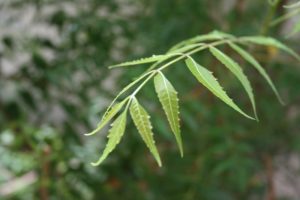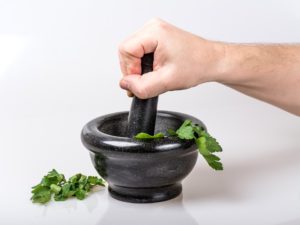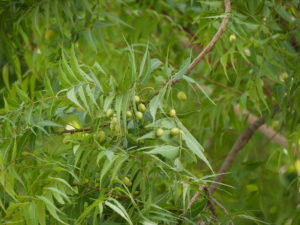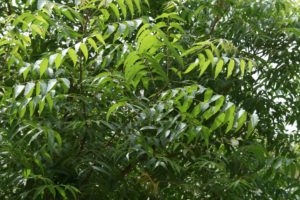
Why Neem Is Regarded As ‘Green Treasure’?
Neem (Azadirachta indica) commonly known as ‘Indian Lilac’ or ‘Margosa Tree’ is the most versatile tropical evergreen tree. Neem is referred to in Sanskrit as ‘Arista’ which means perfect, complete and enduring.
How Neem Benefits?
Most parts of Neem tree like for instance the fruits, seeds, leaves, bark and roots contain compounds with proven health properties –
- antiseptic,
- antiviral,
- anti-pyretic,
- anti-inflammatory,
- anti-ulcer,
- antimicrobial
- and anti-fungal properties.
Neem is holder of abundant medicinal potential and it is therefore believed that each part of the Neem tree encompasses medicinal virtues.
Neem Is Researched
A lot of research has been focused in the last five decades on the effectiveness of biological activity and medicinal applications of Neem tree. And in short it is know now that Neem is recognized as an important natural source for developing medicines and industrial products.
- The usefulness of the Neem tree has been recognized internationally where the US National Academy of Sciences, published a report (1992) entitled ‘Neem – a tree for solving global problems’.
- It documented the advancement of Neem research and its growing importance especially in the modern medicine.
- The most active biological constituent of Neem is Azadirachtin which is a mixture of seven isomeric compounds.
- The Limonoid compounds present in Neem contain insecticidal and pesticidal activities and are generally used in the pharmaceutical, soap and pesticide industries.
- Researchers have proved that the leaves and seeds of Neem contain Azadirachtin which is beneficial against many types of fungal, viral and parasitic diseases.
What Ayurveda Says?
Neem is native of India and is widely documented in ancient Ayurvedic science as well as in the modern study of herbs. Neem and its medicinal value is matched with ample medical literature and is proving to be a new molecule for management of various diseases where researchers are exploring the therapeutic potential of this plant that has already been documented by Ayurveda 5000 years ago.
As per Ayurveda, Neem is widely used more importantly for its property to control ‘Pitta dosha’ or excess heat condition.
Neem is bitter in taste and its various parts are useful and exhibit wide biological activity like –
- anti – allergic,
- anti- dermatitis,
- antifungal,
- anti-inflammatory,
- anti – pyorrhoea,
- anti-scabetic,
- cardiac,
- diuretic,
- insecticidal,
- larvicidal,
- nematicidal,
- spermicidal
- and other biological activities.
And because of these activities Neem has however found enormous applications making it a green treasure.
Varied Usage Of Neem
Beauty Care
Neem is widely used all over the world in cosmetics and body care products in various forms like soaps, oils, cream and body lotion etc. which help to maintain healthy and radiant skin and so also protects against damage due to exposure of sun.
Medicinal Usage
As herbal remedy, Neem capsules have demonstrated excellent results for almost all skin diseases like –
- Acne,
- Eczema,
- Psoriasis,
- Scabies,
- Herpes,
- Athlete’s Foot,
- Yeast infection,
- Candida and many more.
Skin Care
Traditionally, Neem leaves, and Neem products have been used widely against variety of skin ailments like –
- rashes,
- boils,
- wounds,
- jaundice,
- leprosy,
- chicken pox,
- stomach ulcers
- skin allergies etc.
Modern Medicine
Modern science also has confirmed the super-curative power of Neem for many diseases providing promising indications of Neem to be used much more widely.
Neem Case Studies
Case Study 1.
A successful study was performed on the different antimicrobial properties of Neem which revealed that the leaf extract of Neem showed antiviral activity against group B coxsackie viruses. A decoction of Neem leaves relieved –
- nose troubles
- healed wounds,
- stomatitis / Mouth ulcers
- and cured bad gums.
For these benefits, either Neem was applied externally or used as a gargle.
Also the leaves contained amazing health and healing properties of being naturally –
- carminative
- and expectorant,
- anti-inflammatory,
- anti-rheumatic,
- useful in syphilitic sores,
- earache,
- boils,
- in all blood impurities.
Case Study 2.
A study (Kumar & Gupta, 2002) reports Neem to be –
anti-tumor,
used for hepato-renal protecting activity
and hypolipidemic effect.
Awesome Medicinal Values
Neem is holder of great medicinal vaues. Therefore, it has been evaluated for –
- being anti-diabetic
- has shown positive impacts in reducing glucose, triglycerides, creatinine, lipids & urea.
- The extracts from young flowers and leaves of Neem have high antioxidants.
- Neem is most effective in treating skin disorders like scabies and lice.
- The Neem bark was most effective in healing ulcers, reducing human gastric acid hyper-secretion & gastro-duodenal ulcers.
- Neem is known to be blood purifier that effectively removes toxins and neutralizes the free radicals existing in body.
Multiple Usage Of Neem
In addition, the uses of Neem have been seen in the fields of –
- Environment,
- Agriculture,
- Veterinary,
- Medicine
- Beauty Industry.
Scientifically, the antibacterial activity of Neem has been evaluated by means of gel filtration chromatography & agar diffusion analysis on Salmonella typhi, Escherichia coli, Staphylococcus epidermidis & Staphylococcus aureus bacterial strains.
Gain For Wellness Garments
While there are multiple ways in which Neem can be brought to use, another distinctive property of Neem makes the Neem plant material extract greatly adapting to the binding agent selected from the group consisting of Lignin and Tannins. In other words, while this provides an overall synergistic effect, it moreover renders enhanced protection and fortification from environmental forces. Whereas applications of Lignin prove that Lignin acts as free radical scavengers and is holder of natural antioxidant properties; the additive quantities of Lignin and Tannin far exceed the naturally occurring quantities of the same in the Neem plant. Thus, when the wellness garments which are essentially treated with Neem and fortified with Lignin and Tannins, can be extraordinarily beneficial and wellness promoting.
REFERENCES:
- Jones et al., 1994;
- Sankaram et al., 1987;
- Basak and Chakraborty 1968;
- Thind and Dahiya, 1977;
- Khan et al.,1991;
- Suresh et al,1974;
- Parveen and Alam, 1993;
- Steinhauer, 1996;
- Biswas K, Chattopadhyay I, Benerjee RK, Bandyopadhyay U (2002). Biological activities and medical properties of neem (Azadirachta indica). Current Sci., 82(11):701-711.
- Tewari SN, Nayak M (1991). Activity of four plant leaf extracts against three fungal pathogens of rice. Tropical Agriculture (Trinidad) 68:373-375.
- Thind TS, Dahiya MS (1977). Inhibitory effects of essential oils of four medicinal plants against keratinioholic fungi. East Pharmacology,20:147-148.
- www.neemauranaturals.com
- Anonymous (1996). The Indian pharmacopoeia.Government of India, New Delhi.Ministry of Health and family welfare.
- Bandyopadhyay U, Chatterjee R, Bandyopadhyay RK (1998). Process for the isolation of an active principle from Azadirachta indica useful for controlling gastric hyperacidity and gastric ulceration. US patent No. p. 5730986.
- Hammer KA, Carson CF, Riley TV (1999). Antimicrobial activity of essential oils and other plant extracts. J. Appl. Microbial., 86(6): 985.
- Kher A, Chaurasia SC (1977). Anti-fungal activity of essential oils of three medicinal plants. Indian Drugs, 15: 41–42.
- Anonymous, (1985) The wealth of India – Raw materials. Publication and Information Directorate, CSIR, New Delhi, India.
- Roxburgh, W., (1874) Description of Indian plants. Today and tomorrow’s Printers and Publishers, NewDelhi, India.
- Siddiqui, B.S., Afshan, F., Gulzar, T., et al., (2004)Tetracyclictriterpenoids from the leaves of Azadirachta indica. Phytochemistry 65: 2363-2367.
- Jacobson, M., (1991) The Neem Tree. CRC press, Boca Raton, U.S.
- Suri, R.K., Mehrotra, A., (1994) Neem (Azadirachta indica A. Juss.) A Wonder Tree. Society of Forest
and Environmental Managers, Dehra Dun, India.
- Tanzubil, P.B., (1996) Potential for neem (Azadirachta indica A. Juss.) in armyworm control in Africa. In: Neem and Environment (Vol. I) (Singh, R.P., Chari, M.S., Raheja, K., et al., eds.). Oxford and IBH publishing Co. Pvt. Ltd., New Delhi, India.
- International Research Journal of Biological Sciences, ISSN 2278-3202, Vol. 1(6), 76-79, October (2012) I. Res. J. Biological Sci.
- Neem (Azadirachta indica A. Juss) – A Nature’s Drugstore: An overview, Imam Hashmat, Department of Preventive and Social Medicine, National Institute of Unani Medicine, Bangalore, INDIA , Hussain Azad, Department of Moalajat, National Institute of Unani Medicine, Bangalore, INDIA and Ajij Ahmed, Department of Ilmul Advia, National Institute of Unani Medicine, Bangalore, INDIA
- In-Vitro Antibacterial Activity of Two Medicinal Plants, Neem (Azadirachta indica) and Peppermint, S. Irshad et al / Intl. R. J. of Pharmaceuticals (2011), Vol. 01, Issue 01, pp. 9-14 ISSN 2048-4143
Article Published Here.
Watch Video: Home Remedies for Mouth Ulcers (मुँह में छाले के लिए आसान घरेलू इलाज)
About the Author:
Dr Sonica Krishan is Author and Speaker in the areas of Healthy and Joyous Living through Ayurveda, Meditation, Yoga and other Contemplative practices. She is a leading Ayurveda Professional in India. She is also Health Writer, Columnist, Editor, Ayurveda Consultant and Holistic Healing Coach. Dr Sonica is open for National as well as International Collaborations with interested people / institutions in fields of Ayurveda, Meditation and Yoga.
Dr Sonica Krishan’s Books are available at Amazon
Related Blogs:
AYURVEDA HERBS AND HOME REMEDIES FOR URTICARIA SKIN ALLERGY
HOW TO HANDLE SEASONAL ALLERGIES NATURALLY?



